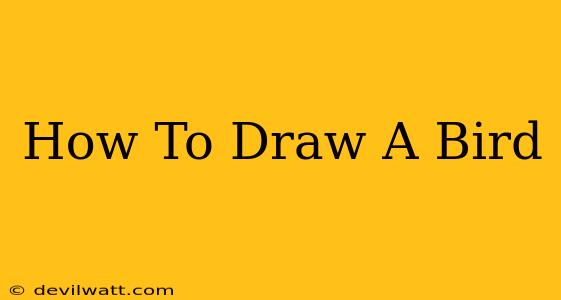So you want to learn how to draw a bird? Whether you're a seasoned artist or picking up a pencil for the first time, this guide will walk you through the process, step-by-step. Drawing birds can seem intimidating, but by breaking it down into manageable shapes and focusing on key features, you'll be creating feathered friends in no time!
Understanding Bird Anatomy: The Foundation of Your Drawing
Before you even pick up your pencil, it's helpful to understand a bird's basic structure. This isn't about becoming an ornithologist, but recognizing a few key elements will drastically improve your drawings.
Key Shapes to Focus On:
- The Body: Think of the body as a slightly elongated oval or teardrop shape.
- The Head: A smaller circle or oval, connected to the body.
- The Beak: This varies wildly between bird species, but can often be simplified into a triangle or a cone shape.
- The Wings: These are more complex, often shaped like slightly curved teardrops or elongated commas. Consider the wing's position – are they folded, outstretched, or in flight?
- The Tail: The tail can be short and stubby or long and elegant. Observe its shape and how it interacts with the rest of the bird's body.
- The Legs and Feet: These are crucial for grounding the bird and adding realism. Pay close attention to the number of toes and their arrangement.
Step-by-Step Guide to Drawing a Simple Bird
Let's draw a simple robin. This will help us apply the shapes we just discussed.
Step 1: Sketch the Basic Shapes: Lightly sketch the basic oval for the body, the circle for the head, and a small triangle for the beak.
Step 2: Add the Wings: Sketch the wings as curved teardrops extending from the sides of the body.
Step 3: Define the Tail: Add a simple tail feathers using slightly curved lines.
Step 4: Add the Legs and Feet: Sketch two thin lines for the legs, followed by small shapes for the feet. Consider the angle and position of the feet, depending on whether the bird is perched or standing.
Step 5: Refine the Details: Once you're happy with the basic shapes, start adding details. This could include adding individual feathers, refining the shape of the beak, and adding eye detail.
Step 6: Add Texture and Shading: Use shading to add depth and realism to your bird drawing. Observe how light falls on the bird's feathers and use shading techniques to mimic this. Consider using a variety of shading techniques, such as hatching, cross-hatching, and blending, to create a realistic look.
Different Types of Birds, Different Approaches
Remember that birds come in a vast array of shapes and sizes. The basic shapes we've discussed serve as a foundation, but you'll need to adapt your approach depending on the specific bird you're drawing. Observing real birds or reference images is crucial for capturing their unique characteristics. Study their beaks, wing shapes, and posture to enhance the accuracy and realism of your drawings.
Practice Makes Perfect!
Drawing birds is a skill that improves with practice. Don't get discouraged if your first attempts aren't perfect. Keep practicing, experiment with different techniques, and most importantly, have fun! The more you draw, the better you'll become at capturing the beauty and grace of these amazing creatures. Try drawing different species, experimenting with different poses and perspectives to further improve your skills and build your confidence. Happy drawing!

